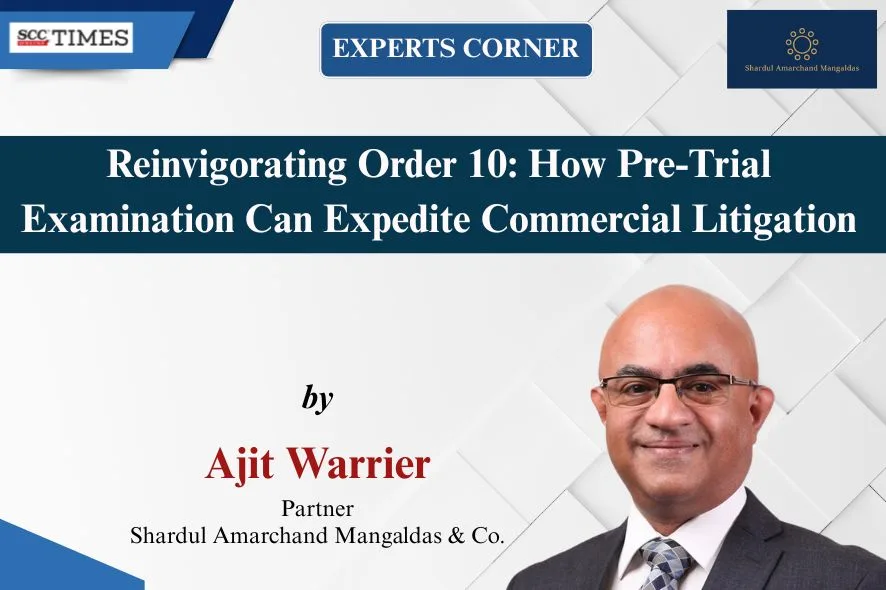The Statement of Objects and Reasons in the Commercial Courts Act, 2015 (the 2015 Act) highlighted the need for an independent mechanism for the early resolution of commercial disputes involving complex facts and law. The legislative objective was that swift resolution of such disputes would enhance investor confidence in the independence and efficiency of the Indian legal system.
To this end, the 2015 Act amended the Civil Procedure Code, 1908 (the Code) by introducing strict timelines, case management hearings, and summary judgments via Section 16. These changes aimed to ensure greater clarity in commercial suits, aligning procedure with the needs of contemporary business disputes. Despite these intentions, commercial litigation in India often continues to suffer from procedural delays. A significantly underused procedural tool that can accelerate proceedings is the power of examination under Order 10 of the Code. When used with strategic insight and resolve, Order 10 allows lawyers and courts to clarify pleadings, expose unsupported defences, and expedite dispute resolution, making it invaluable for practitioners.
Legislative basis and purpose
Order 10 empowers courts to orally examine parties at the outset. Rule 1 allows examination to determine which allegations are admitted or denied; Rule 2 authorises further questioning to clarify matters in controversy. The overarching intent is to avoid unnecessary evidence and streamline the trial process.
The Supreme Court in Kapil Corepacks (P) Ltd. v. Harbans Lal1, clarified that Rule 1 is to be invoked where a party fails to clearly admit or deny allegations made against him by the other party. Rule 2, by contrast, may be used to elucidate any matter in controversy and clarify obscure pleadings or documents, although it is not intended as a substitute for cross-examination prior to trial.
In A. Shanmugam v. Ariya Kshatriya Rajakula Vamsathu Madalaya Nandhavana Paripalanai Sangam2, the Supreme Court emphasised that prior to the framing of issues, a judge should critically examine the pleadings of the parties and invoke Rule 2 in its search for the truth and narrow down, or even eliminate, the controversy.
Judicial emphasis and the litigator’s role
In Ambalal Sarabhai Enterprises Ltd. v. K.S. Infraspace LLP3, the Supreme Court (in the concurring judgment passed by R. Banumathi, J.) emphasised that provisions of the 2015 Act, including case management and timelines, require judges to take a proactive stance in resolving commercial disputes. The Courts must enforce strict timelines and actively manage cases, with litigators playing a central role in ensuring the timely clarification of issues for precision and speed.
Practical applications for litigators
Order 10 can be used to great effect in a range of commercial suits:
1. Vague denials in debt recovery: Plaintiffs can use Order 10 to require specific responses regarding receipt of goods/services, payments, and reasons for non-payment, exposing evasive defences and potentially facilitating summary judgment.
2. Authenticity of documents: When the execution of a contract is blankly denied, Order 10 can require the defendant to clarify the grounds for denial (for example, forgery or non-execution) narrowing the dispute to specific factual issues.
3. Joint venture or shareholder claims: In matters where pleadings are unclear about capital contributions or board decisions, Order 10 questioning can clarify admissions regarding key facts such as board resolutions or profit shares, streamlining future evidence.
4. Performance or service deficiency disputes: Litigators can use Order 10 to compel defendants to specify the nature of alleged failures and adherence to protocols, making the issues more concrete and aiding in targeted evidence or summary disposal.
5. Frivolous or vexatious defences: Where a defendant makes unsubstantiated claims (for example, alleging forgery without particulars) Order 10 is an effective device to press for details. If the defence collapses under scrutiny, the court may use Order 13-A to summarily dispose of the suit.
Judicial techniques to uncover core issues
By virtue of Rule 2 Order 15, a Commercial Court can, prior to framing of issues, invoke powers under Rule 2 Order 10 at a case management hearing after examining pleadings and documents produced before the court. Further, Rule 4 Order 19 empowers the court to issue directions to regulate evidence by identifying the issues on which evidence is actually required.
The 2015 Act also enables a party, by leave of the court, to deliver interrogatories in writing for examination of the opposite party or parties (Rule 2 Order 11, as amended). Where any person required to answer the interrogatories omits to answer, or answers insufficiently, the party delivering the interrogatories is entitled to apply to the court for an order requiring him to answer or to answer further, and an order may be made requiring him to answer through affidavit or viva voce examination in court.
Judges who leverage Order 10 at the first hearing can steer cases towards their real core issues. By pressing for clear admissions and denials, the process identifies the true questions for resolution, reduces unnecessary evidence and curtails vague pleading strategies. This approach can also foster early settlements or alternative dispute resolution. When robustly employed, Order 10 aligns with both statutory and judicial emphasis on substance over form, contributing to timely resolution and justice in commercial matters.
Conclusion
Despite the absence of credible data, the general impression (based on publicly reported judgments) remains that Order 10 remains underutilised in commercial litigation and the reasons for this are as much cultural as procedural. Apprehensions about judicial overreach, tactical reluctance to make early admissions, and absence of structured case management practices have often deterred its robust invocation.
In an environment of growing complexity and caseloads, rigorous use of Order 10 at the early stages of a commercial litigation can radically transform the pleadings process, support the legislative goal of efficiency, and promote just and timely outcomes in commercial disputes. When embraced by proactive judges and counsel, Order 10 can also serve as a powerful tool for clarifying issues and expediting commercial litigation — clarifying pleadings, narrowing disputes, and realising the 2015 Act’s objective of swift and efficient adjudication.
*Partner, Shardul Amarchand Mangaldas & Co., specialising in Dispute Resolution, Litigation and Arbitration.
1. (2010) 8 SCC 452 : (2010) 3 SCC (Civ) 400 : (2010) 3 SCC (Cri) 924.
2. (2012) 6 SCC 430 : (2012) 3 SCC (Civ) 735.



